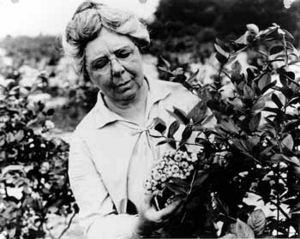Elizabeth Coleman White facts for kids
Quick facts for kids
Elizabeth Coleman White
|
|
|---|---|
 |
|
| Born | October 5, 1871 |
| Died | November 11, 1954 (aged 83) |
| Parent(s) | Mary Fenwick Joseph Josiah White |
| Relatives | Barclay White, grandfather |
Elizabeth Coleman White (born October 5, 1871 – died November 11, 1954) was a clever woman from New Jersey. She worked with a scientist named Frederick Vernon Coville. Together, they helped create and sell the delicious blueberries we eat today!
Elizabeth's Early Life
Elizabeth Coleman White was born on October 5, 1871, in New Lisbon, New Jersey. She was the oldest of four daughters. Her parents, Mary A. Fenwick and Joseph Josiah White, were Quakers. Elizabeth finished school at Friends' Central School in Philadelphia, Pennsylvania, in 1887.
After school, Elizabeth helped out on her father's farm. They grew cranberries there. She helped supervise the people picking cranberries. In the colder months, Elizabeth kept learning new things. She took classes in first aid, photography, and even how to make clothes and hats. She studied at Drexel Institute, which is now Drexel University.
Elizabeth was a pioneer in her field. She was the first woman to join the American Cranberry Association. She was also the first woman to get a special award from the New Jersey Department of Agriculture. In 1927, she helped start the New Jersey Blueberry Cooperative Association. This group helped blueberry farmers work together.
Elizabeth passed away from cancer in Whitesbog, New Jersey, on November 11, 1954. She was 83 years old.
The Blueberry Story
Elizabeth White became very interested in the wild blueberries growing near her family's cranberry farm. She wanted to grow them on purpose! She thought they could use the land between the cranberry bogs in the summer. This way, they wouldn't interfere with the cranberry harvest in the fall.
Elizabeth read a book by a scientist named Frederick Vernon Coville. He worked for the United States Department of Agriculture. His book was all about growing blueberries. Elizabeth contacted him and offered her family's unused land for his experiments. Coville agreed to help! Elizabeth was in charge of the land. She also found wild blueberry bushes to grow. Coville, on the other hand, shared his scientific knowledge about plants.
They carefully chose which wild blueberries to grow. They looked at things like how they tasted, their color, their shape, and how long they took to ripen. Elizabeth hired local woodsmen to help her find the best bushes. She paid them a few dollars for each bush they found that had berries at least 5/8 inches big.
Once found, the bushes were tagged. Then, Coville would dig them up and graft them. Out of 120 wild bushes they collected, only two were perfect! From these two special bushes, they grew thousands of new hybrid bushes. They kept choosing the best ones to create the modern cultivated blueberries we know today.
In 1916, Elizabeth White and Frederick Coville successfully grew their first blueberry crop. They sold these new blueberries under a special name: Tru-Blu-Berries. Elizabeth also had a great idea for packaging. She saw cellophane used for candy wrappers and thought it would be perfect for blueberries too!

